

“Project Management is the art of managing all the aspects of a project from inception to closure using a scientific and structured methodology” (Management Study Guide).
Project management involves planning the task and resources to cover all the restraints, including the cost, time and budget, etc. Project management can be employed everywhere, i.e., in services, products, or anything else.
Project management software is software that plans and tracks all aspects of a project or a venture. Project managers and individual team members gain visibility on workflows. Gantt charts track progress. Project management apps are also a type of collaboration software. There’s real-time resource management and customizable workflow management. Task lists and subtasks let large and small teams distribute work effectively.
Team collaboration also benefits from timesheets and time tracking tools. Assets and information are centralized with document management, file sharing, and file storage.
These apps enable businesses to control expenses and observe time constraints. To monitor complex projects and make collaborative work more productive and efficient. Project management systems are available as SaaS cloud-based and on-premise solutions. And they typically come with a mobile app for work on the go.
Wrike is a comprehensive project management solution. It’s designed to create complete visibility and transparency on projects and tasks. To improve team collaboration, speed up approvals, and handle incoming work requests. Compliance and auditing are made easy. They let you keep track of and monitor the employee’s tasks. You can also print reports for individual team members and determine project hours. There are strong data reporting tools. It allows you to add Business Intelligence (BI) features for advanced reporting and analytics.
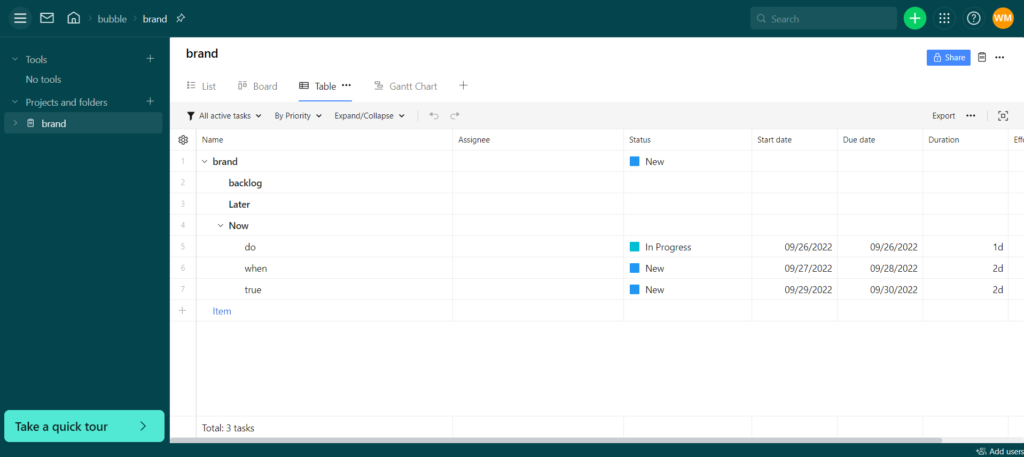
Top Features:
Drawbacks:
The user interface isn’t as automated as it could be which can delay full-team adoption. App setup is likewise fairly involved.
Pricing:
You can avail a free plan for up to 5 users.
For 5 to 15 users, you can go for the professional plan that costs about $9.80 per user/month, billed annually.
The business plan for 5-200 users is $24.80 per user/per month, billed annually.
Enterprise plan for 5-Unlimited users requires contact with the Wrike sales team.
Professional, Business and Enterprise plans come with a 14-day free trial.
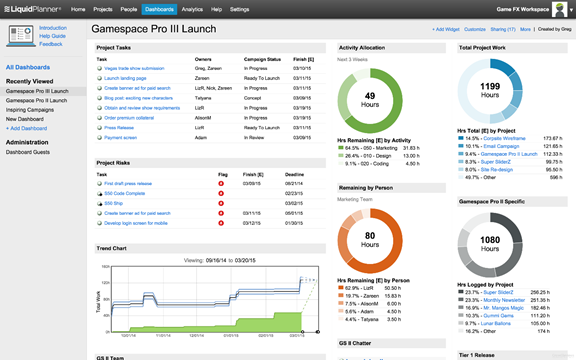
Allows you to manage any variability of projects, and adjust to changes. In other words, the “liquid” nature of work. Move ahead with team availability, priorities, and any scheduled employee vacation time in mind—smart scheduling plans for the best and worst case scenarios. Estimate time ranges and better manage resources and risk.
Build a macro pipeline for managing all company projects. See pending, approved, and active projects. Manage and prioritize projects with an easy drag-and-drop user interface.
Top Features:
Drawbacks:
Has a moderate learning curve, and will take some training to use to its full potential. Lacks offline access.
Pricing:
The professional plan is $45 per user/per month, billed annually.
The enterprise plan requires contact with LiquidPlanner.
A 14-day free trial is available for the Professional plan. No credit card is required.
Trello is a simple, visual web-based project organizing software. It’s a flexible and easy-to-use task management tool. Built around Kanban boards for managing productivity workflows. Information is visible on cards at a glance. You can add comments, attach files, and set due dates on each card. Create useful lists too.
The application has long been a favorite of freelancers, startups, and small teams. It’s even touted as a way to organize your upcoming family vacation. That’s the level of simplicity we’re talking about.
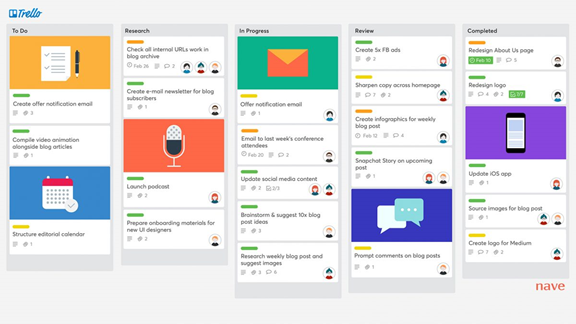
Top Features:
Drawbacks:
Trello isn’t a heavyweight project management tool. If your project is truly complex (like say software development), it might not have the tools you need. Particularly if you’re looking for detailed analytics and metrics.
Pricing:
The free plan is available, with unlimited cards and a 10MB limit per attachment.
The business Class plan is $9.99 per user/per month billed annually, and $12.50 per user per month billed monthly.
Enterprise Class plan for 20+ users is $17.50 per user/per month, billed annually. The price per user drops as the number of users increases.
A 14-day free trial is available for the Business Class plan.
Asana helps teams collaborate on projects. To track tasks and communicate through the platform’s many dashboards. One can view all their tasks as a list form, or see them plotted onto a calendar. There’s a board view, which follows the Kanban logic of moving tasks through stages.
Asana includes tools for conversation and file sharing, which means team members don’t need to rely on emails, other chat apps, or cloud platforms to share comments and media.
The timeline feature is sort of a mix between a calendar and a vision board. Projects get mapped out according to an ideal plan. That keeps everyone involved and motivated to meet deadlines.
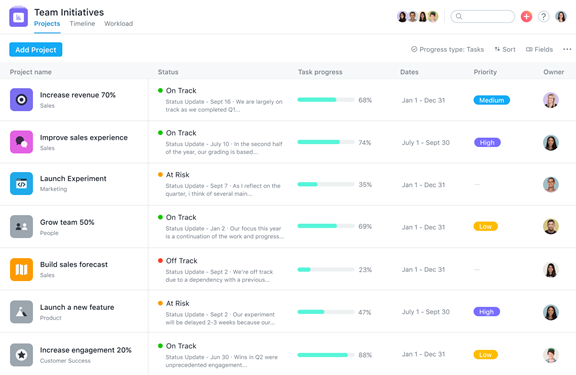
Top Features:
Drawbacks:
There are a lot of features, and it can be confusing to set up your workflow. The task layout view is not super intuitive. You have to click around quite a bit to get to sub-tasks.
Also, sometimes Asana sends you many email notifications. This can make it tricky to sort out what’s an important update and what’s not.
Pricing:
The basic plan for individuals and teams is free.
The premium plan is $10.99 per user/per month billed annually, and $13.49 per user/month billed monthly.
The business plan is $24.99 per user/per month billed annually, and $30.49 per user/month billed monthly.
The Enterprise plan requires contact with Asana.
Formerly known as Dapulse, monday.com is a project management app with a rock-solid reputation. It is preferred for having a neat interface that puts collaboration tools front and center. And for syncing information across work applications. It lets you organize workflows and tasks. It encourages productivity and gives everyone a heads-up on what they need to do.
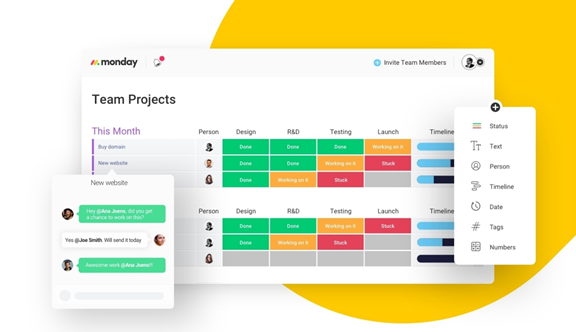
Top Features:
Drawbacks:
The mobile version has been described by some users as “clunky.” It lacks some of the desktop app’s features. Lacks a call recording feature.
Pricing:
The basic plan is $25 per user/per month, billed annually.
The standard plan is $39 per user/per month, billed annually.
The Pro plan is $59 per user/per month, billed annually.
Enterprise plan requires contact with Monday.com.
A 14-day free trial is available without a credit card. It includes unlimited users and boards.
Cloud-based tool for managing project teams. Helps plan work, track it, and collaborate over distances. Gantt charts help you build a project plan. Keep track of critical tasks. See, at a glance, if there’s a gap between planned progress and reality. Automate routine tasks to save yourself time. Use a drag-and-drop interface to visualize and build up automation rules. Timesheets let you log billable and non-billable hours. This is super helpful for invoicing. There’s direct integration with Zoho Invoice as well, which will auto-generate invoices from timesheets.

Top Features:
Drawback:
The user interface is not the most intuitive or aesthetically pleasing. The search function is limited to tasks within specific projects.
Pricing:
A free plan for up to 3 users and 2 projects is available.
The standard plan for 6-10 users is $2.50 per user/per month billed annually, and $3 per user/per month billed monthly.
Express plan for 12-50 users is $3 per user/per month billed annually, and $4 per user/per month billed monthly.
A premium plan for 15-100 users is $4 per user/per month billed annually, and $5 per user/per month billed monthly.
Enterprise plan starting at 20 users is $5 per user/per month billed annually, and $6 per user/month billed monthly.
A 10-day free trial is available for all paid plans.
Targeted Agile and Lean software development teams. Features knowledge management, development workflow, and continuous integration and deployment tools. You can keep adding depth and complexity to projects. Assign tasks and make one task reliant upon another. Create mini projects within bigger ones. Jira is very customizable, and there are many ways to extend its features further. Jira offers very strong data encryption and security. It has broad security compliance with ISO/IEC 27001 and the US/EU Privacy Shield. As well as many other programs.
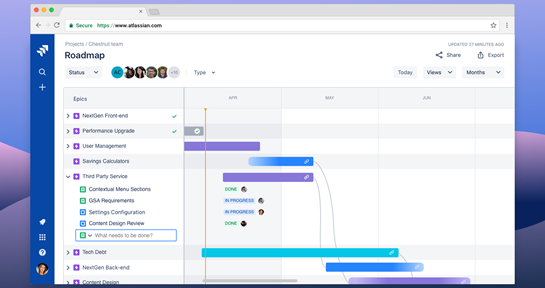
Top Features:
Drawbacks:
The UI is unconventional and thus it can be difficult for the user to find and make sense of the workflow. This gives the platform a moderate learning curve.
Pricing:
A free plan for up to 10 users is available.
The standard plan for up to 5,000 users is $7 per user/per month, billed annually.
The premium plan for up to 5,000 users is $14 per user/per month, billed annually.
A 7-day free trial is available for the Standard and Premium plans.
ClickUp is another project management software tool with a range of features that allows you to manage and complete all your team’s projects on a single platform. It enables the user to manage their projects and tasks in a centralized environment, where they can communicate with other team members and clients. It allowed the users to manage their tasks using the checklist and dividing them into subtasks, moreover, it offers features like searching, sorting, and filtering. Another feature of this software is, it provides the user with the visualization tools such as Gantt charts, calendars, and timelines.
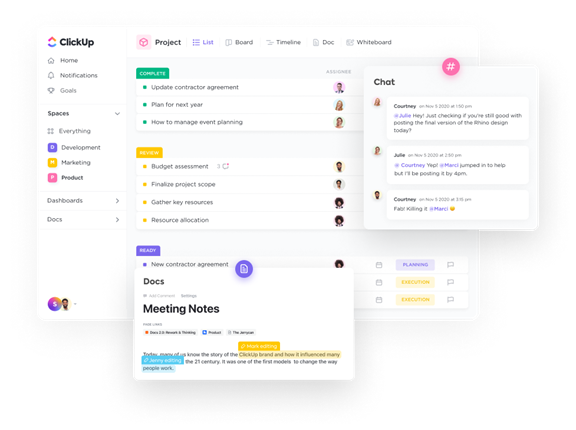
Top Features:
Drawbacks:
Read-only guest permissions are limited to a paid account
Reporting suite is limited to paid plans only
Granular customization options result in a time-consuming set-up
Pricing:
It comes with different plans including
FREE FOREVER: This plan is for personal use/ Free
UNLIMITED: For small teams/ $5 per member per month
BUSINESS: It can be used for mid-sized teams/ $12 per member per month
BUSINESS PLUS: This plan is designed for multiple teams/ $19 per member per month
ENTERPRISE: This plan is best to be used by large teams with many members e.g. Contact the sales department